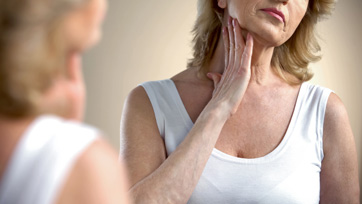As women reach menopause, the estrogen level throughout the body declines naturally. This natural reduction in estrogen leads to estrogen deficient skin, which is the key factor that contributes to aging skin.
What Is Cutaneous Aging?
Cutaneous aging is a complex biological phenomenon which occurs in all human beings. It is a result of a combination of genetic, environmental, chronological and hormonal factors. While we cannot make changes to our genetics, our age or our previous environmental exposures (at least not yet!), we can make safe and natural adjustments to our hormonal depletion. Estrogen is a steroid hormone which is mainly synthesized in the ovaries of pre-menopausal women. Once you are post-menopausal, estrogen synthesis mainly occurs in peripheral tissues such as adipose tissue (fat cells) and adrenal glands.
Estrogen plays a major role in keeping skin healthy and fights against aging skin. Estrogen also helps to restore skin moisture by promoting sebum secretion. Sebum is an oily substance secreted by the sebaceous glands of skin to keep our skin moisturized.
When estrogen levels are low, which occurs most often after menopause, the collagen in the skin decreases, thus making your skin prone to symptoms of aging. In some pre-menopausal women low estrogen can be iatrogenic (as a result of certain treatments) which leads to skin manifestations.
What Are The Symptoms Of Aging Skin?
The most common symptoms of aging skin are as follows:
- Low estrogen levels decrease skin collagen content, which results in reduced skin thickness
- Aging skin is characterized by thinning, wrinkling and lines
- Sagging (looseness) – this occurs due to decreased production of collagen and elastin
- Skin dryness – one of the earliest symptoms of low estrogen
- Decreased elasticity and firmness
- Age spots – the melanocytes (pigment cells) in your skin multiply more rapidly and cluster together forming age spots
- Dull skin tone – as you age, dead skin cells build up with time and your youthful glow can be compromised, making your skin tone dull.
How Does Estrogen Depletion Affect the Skin and Collagen?
Collagen is synthesized mainly in fibroblast cells in connective tissues in our body organs and skin. Estrogen stimulates the process of collagen synthesis. Progressive reduction of skin thickness in estrogen deficient skin is mostly due to the loss of skin collagen. When estrogen levels are low, collagen synthesis is reduced with a decline in collagen deposition. Low estrogen accelerates the loss of skin elasticity leading to wrinkles, by triggering ultra-structural changes in elastic fibers of our skin.
What Can We Do To Overcome Symptoms of Aging Skin and Estrogen Deficient Skin?
We cannot reverse genetics and chronological factors. However, we can work towards changing environmental factors which contribute to the signs of aging skin. By reducing excessive sun exposure and by using a good sunscreen when we go out can protect our skin from photo-aging, skin damage caused by excessive sun exposure, specifically UVA and UVB rays. Eating a nutritious and balanced diet, engaging in regular exercise, reducing our stress levels and quitting smoking all help fight aging skin.
Estrogen receptors in the skin bind to estrogen that is externally introduced. Here is the good news! Topical estrogen therapy is shown to increase collagen synthesis. Topical estrogen creams or gels have shown to be effective against aging skin with almost no adverse effects.
Studies have shown that natural topical isoflavone use has significantly improved skin dryness, roughness, facial wrinkles and looseness of skin. Isoflavone is a plant substance which acts like estrogen. This stimulates collagen synthesis as well as reduces breakdown of collagen by enzymes. Isoflavone and synthetic estrogens bind well to estrogen receptors found in skin.
If you suspect you have estrogen deficient skin and are interested in treatment options, call APDKC today at 913-469-1115 to schedule an appointment. Our caring professionals will provide you with a thorough skin examination and a topical cream to slow the signs of aging today.

